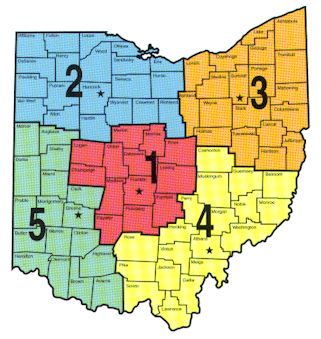Catching big bass in Ohio
Ohio has a recognition program for anglers that catch largemouth bass over 21 inches and smallmouth bass over 20 inches. They record the weight, body of water it was caught on, and other details.
Every year, about 800-1000 fish are caught that fit into the above category. Usually it’s about 800 largemouths and 200-300 smallmouths that qualify. So about 1000 pretty large fish are caught. We have lots of detailed information about them.
The most productive body of water for large largemouth and smallmouth bass every year is still Lake Erie, The majority of big smallmouth were caught off rocky shores and around the islands. While the biggest largemouth were caught near the harbors; Maumee, Sandusky, Catawba, Marblehead, Cleveland, Fairport Harbor, Geneva, Ashtabula and Conneaut. Which gives you a huge stretch where you can catch largemouth.
The next most productive bodies of water for large bass have been the AEP Rcreation area south of Cambridge and Zanesville, between McConnelsville and Cumberland. This can be found o Google Maps Here. This area is free to fish, but you must apply for a permit online. You will need an Ohio fishing license too. It’s privately owned by the America Electric Power company and they are doing their best to take care of the land. There are over 1500 acres of water in 600 lakes in this region and the Ohio Division of Wildlife stocks these ponds with bluegill and bass.
The third most productive body of water for bass has been the Portage Lakes chain of lakes. This area offers 2000 acres of fishable water. This area is just south of Akron Ohio and can be found on Google Maps Here. Tons of large bass have been caught in this system.
The fourth most productive body of water has been the Mogadore Reservoir found on Google Maps Here. This reservoir is especially good for largemouth bass. It was stocked many years ago and continues to be managed aggressively.
Next is the Clear Fork Lake Reservoir in Mansfield, Ohio that can be found on Google Maps Here. Catching largemouth bass in reservoir can be quite challenging, but is still doable. Slower presentations seem to work better. But power fishing still works.
The second top producing body of water for smallmouth bass (after Lake Erie, of course), is the Ohio River along the southern border of the state of Ohio. Right off the shore of the main river channel is very productive for smallmouth and largemouth. You don’t have to get back into creeks or shallower bodies of water that are offshoots.
The third and fourth most productive smallmouth bodies of water are the Miami and Grand River.
Then you have the Hoover Reservoir for smallmouth in Delaware, Ohio, just northeast of Columbus. Great smallmouth fishing. You can use a small boat up to 9.9 horsepower engines are allowed. This is a very large, nearly 3000 acre body of water.
In northwest Ohio, we obviously have Lake Erie and the Maumee and Ottawa Rivers that produce tons of smallmouth bass. We also have lot of local ponds, parks, farm ponds, and creeks that can also be productive. We will be discussing those in another article.
A small boat in and around the shore of Lake Erie and into some of the river and creek channels, especially the Raisin River in Monroe, Michigan can produce a ton of larger bass.
We also have a lot of local reservoirs in northwest Ohio that can produce; the Swanton, Delta, Fulton, , Williams, Fergusun, and Paulding. No record size fish have been caught from these, but they can be productive at the right time of year.
Reservoir bass fishing can be more challenging than natural lake fishing, unless the reservoir has more natural cover, weedlines, and structure. Most reservoirs are stocked with catfish, saugeye, bluegill, and bass. It takes a while for these number to equilibrate and stabilize. Most of the reservoirs are just large holes in the ground with a soft muddy bottom, and rocks and riprap on the shoreline. Bluegill hide in the riprap, and bass will come near shore to hunt for them, You will also see a lot of top water action with fishing coming up to eat whatever may have blown or fallen onto the water.
